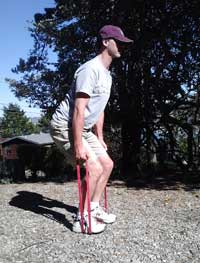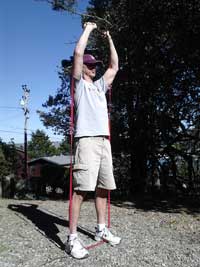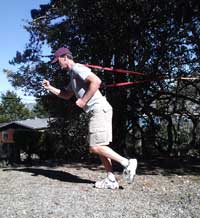Feature Article
Strike Up The Bands

When most people think of training with Resistance Bands, they think of the rubber tubes with handles on the ends that are
used by senior citizens and for some rehab work. That's what I thought a while back. But not any more.
For distinction, the above style of resistance tubing is often called a "sport cord." The resistance bands I'm
talking about are like giant rubberbands and are sometimes called "superbands" (not to be confused with Queen, U2,
or Brainium). Here, I'll just all them "bands."

Bands come in different weights and usually different colors to indicate their resistance level. They can range in width from
1/2 inch to 4 inches. They are extremely durable and a band in good condition is nearly impossible to break while doing exercise
movements (as opposed to, say, towing a jumbo jet). That can make them a little scary at times, but it makes them capable of
delivering some serious workouts.

While bands can obviously be used for strength movements like presses, squats, and rows, they can also be used in other ways.
For example, instead of resistance, they can provide assistance, most often for pullups where one end of the band is attached
to the bar while a foot or knee goes in the other end. They can also be used to provide resistance for movements such as
running, bear crawling, sidesteps, cat herding, etc. Another use for bands is to increase mobility, as a tool in passive
stretching or for
joint flossing or distraction. They can also be used
in advanced training to add resistance to weights such as barbells.
Versatility is just one of the advantages of band training. Another is convenience--they're easy to set up and use without a
lot of space, and they travel well. Another is cost: bands are much less expensive than weights such as barbells, dumbbells,
and kettlebells. And they require less maintenance than cats.

Of course, they're not perfect. While weights like the ones mentioned above will last essentially forever, bands can wear out over time
and require replacement, depending on how they're used. Another problem is that they can be hard on the hands in some
movements, especially the thinner bands. But the biggest problem, I think, is that they can provide unnatural resistance that
leads to bad form. Weights get their resistance from gravity, and we're all used to battling gravity and the line of
resistance we get from lifting a weight is expected. Bands, on the other hand, can offer unusual lines of resistance
depending on how they're set up, and that can make some movements, like squats, feel awkward, especially when they're not
performed correctly. And bands have a resistance that varies throughout the movement: they get more difficult as they get
more stretched.
All things considered, bands are a great investment and an excellent tool for training, especially at home or on the road.
They can help you
stretch your training equipment dollar,
rebound from injury,
resist indolence, and
rubber the wrong way. (The last one may not seem to make much sense but the cats thought it was funny.)
Be seeing you.
-gary